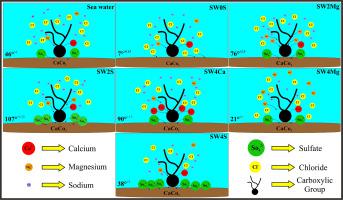Journal of Molecular Liquids ( IF 6 ) Pub Date : 2020-06-27 , DOI: 10.1016/j.molliq.2020.113700 A. Maghsoudian , A. Esfandiarian , S. Kord , Y. Tamsilian , B. Soltani Soulgani

|
Up to now, a large number of studies revealed that smart waterflooding is a cost-effective method by considering the effect of potential determining ions (PDI) on enhanced oil recovery (EOR) in the carbonated reservoir. Current research studied the symbiotic effect of different ions concentration (SO42−, Mg2+, and Ca2+) template in smart water with a constant salinity (40,572 ppm) to justify effective mechanisms at macro and micro scale in a coated carbonated micromodel system. A set of experimental tests such as X-ray diffraction (XRD), compatibility, zeta potential, interfacial tension (IFT), and contact angle (CA) were conducted to determine the type of rock and examine the effect of ions on oil/brines/rock interaction, combined with carbonated coated micromodel flooding tests to determine the optimum smart water solution. Zeta potential tests revealed that the excess amount of SO42− and Mg2+ changed the surface charge into highly negative and positive ones, respectively. Two times excess amount of SO42− (SW2S) had a key role to alter the wettability by measuring CA from 40° to 147°, however, no considerable relation among oil/brines interaction was observed for the IFT reduction. Findings corroborated that Ca2+ and SO42− were the major components for desorbing the carboxylic group from the calcite surface at room temperature. The carbonated coated micromodel flooding results showed that SW2S led to higher ultimate oil recovery (~38%), reconfirmed that wettability alteration was the main mechanism and resulted in better pore-scale performance by less amount of residual oils and discontinuities around the carbonated coated grains.
中文翻译:

直接了解碳酸盐涂层微模型系统中智能注水中SO 4 2−,Mg 2+和Ca 2+离子共生效应的微观和宏观机制
到目前为止,大量研究表明,考虑到潜在的确定离子(PDI)对碳酸盐岩储层中提高的采油率(EOR)的影响,智能注水是一种经济高效的方法。当前的研究研究了不同离子浓度(SO 4 2−,Mg 2+和Ca 2+)的共生效应。)模板在恒定盐度(40,572 ppm)的智能水中,以证明在涂层的碳酸微模型系统中宏观和微观尺度上的有效机理是正确的。进行了一系列实验测试,例如X射线衍射(XRD),相容性,ζ电势,界面张力(IFT)和接触角(CA),以确定岩石的类型并检查离子对油/盐水的影响/岩石相互作用,再结合碳化涂层微模型驱油试验,确定最佳的智能水溶液。Zeta电势测试表明,过量的SO 4 2-和Mg 2+将表面电荷分别变为高度负电荷和正电荷。SO 4 2-的过量两倍(SW2S)通过将CA从40°改变为147°,具有改变润湿性的关键作用,但是,对于IFT降低,没有观察到油/盐水相互作用之间的显着关系。结果证实,Ca 2+和SO 4 2-是室温下从方解石表面解吸羧基的主要成分。碳酸盐涂层的微模型驱油结果表明,SW2S导致更高的最终采油率(〜38%),再次证实润湿性改变是主要机制,并且通过减少碳酸盐涂层的晶粒周围的残留油量和不连续性,导致了更好的孔垢性能。


























 京公网安备 11010802027423号
京公网安备 11010802027423号